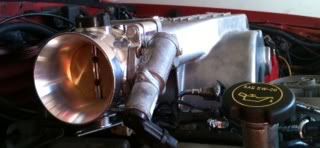Ok a guy I met thru the car shows is selling a built 302 with 351 internals like cam, crank and i think rods doing around 400hp+. I read up on the combo and from what i can tell it's an old school stroker like a 362ish or so. Here's some discussions below pertaining to this and the bold/underlined is the same similar setup he has. My question is being that he's running a carb in a 67 mustang... what would I have to do to make it work if i used the fuel injection setup from my 89? Would tuning be the only thing or more...?
Some 'old school' 302 strokers used 351C or 351W cranks turned down to 302 main journal size, but that was when aftermarket stroker cranks were non-existent and it took a lot of machine work to do. Nowadays aftermarket stroker cranks are uber cheap compared to the machine cost it takes to turn 351C/W cranks down, plus it's not like those factory 351C/W are really abundant.
302 = 2.25" main journals
351C = 2.75" main journals
351W = 3.00" main journals
So yeah, you can put a 3.500" stroke crank in a 302 but it takes a custom combo of rods and pistons to do it, and the aforementioned machine work to the main journals. It ain't cheap. Most of the combos took the 3.500" stroke cranks down to anywhere from 3.300 to 3.400, but some combos kept it at 3.500".
Those kinds of old school strokers were custom jobs all around. It was not just taking the mains down to 2.25" and then dropping the crank in. Cranks journals were not only re-sized, they were offset ground. Cylinder walls were clearanced for the counterweights and rod bolts. Stock rods were not used, and sometimes even turbo four-cylinder Ford or rods for GM or Chrysler applications were required. (Aftermarket) Pistons pins were moved way up, sometimes intersecting the oil control ring land. It was all a very custom job, and not cheap.
Ok I understand now. Between what you and foxchassis said it seems like back in the day the 302 strokers were a lot like the 383 stroker.
Largest displacement limit of a 302 block, using a 351C/W crank, was around 362, and that was with a .060" overbore. That displacement limit was due to piston design limitations (very short compression height) and low rod ratio.
Some 'old school' 302 strokers used 351C or 351W cranks turned down to 302 main journal size, but that was when aftermarket stroker cranks were non-existent and it took a lot of machine work to do. Nowadays aftermarket stroker cranks are uber cheap compared to the machine cost it takes to turn 351C/W cranks down, plus it's not like those factory 351C/W are really abundant.
302 = 2.25" main journals
351C = 2.75" main journals
351W = 3.00" main journals
So yeah, you can put a 3.500" stroke crank in a 302 but it takes a custom combo of rods and pistons to do it, and the aforementioned machine work to the main journals. It ain't cheap. Most of the combos took the 3.500" stroke cranks down to anywhere from 3.300 to 3.400, but some combos kept it at 3.500".
Those kinds of old school strokers were custom jobs all around. It was not just taking the mains down to 2.25" and then dropping the crank in. Cranks journals were not only re-sized, they were offset ground. Cylinder walls were clearanced for the counterweights and rod bolts. Stock rods were not used, and sometimes even turbo four-cylinder Ford or rods for GM or Chrysler applications were required. (Aftermarket) Pistons pins were moved way up, sometimes intersecting the oil control ring land. It was all a very custom job, and not cheap.
Ok I understand now. Between what you and foxchassis said it seems like back in the day the 302 strokers were a lot like the 383 stroker.
Largest displacement limit of a 302 block, using a 351C/W crank, was around 362, and that was with a .060" overbore. That displacement limit was due to piston design limitations (very short compression height) and low rod ratio.


Comment